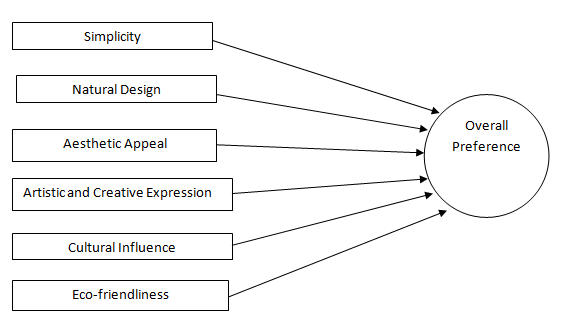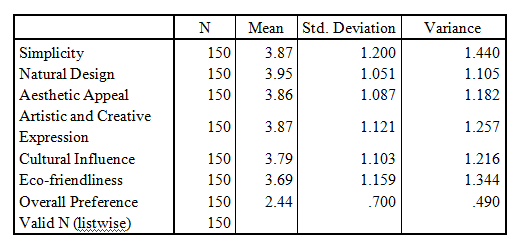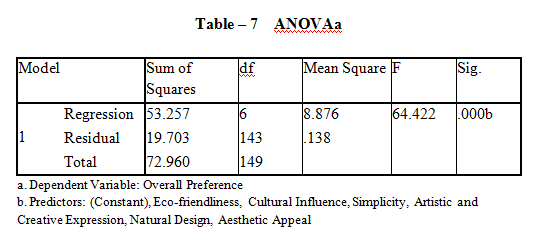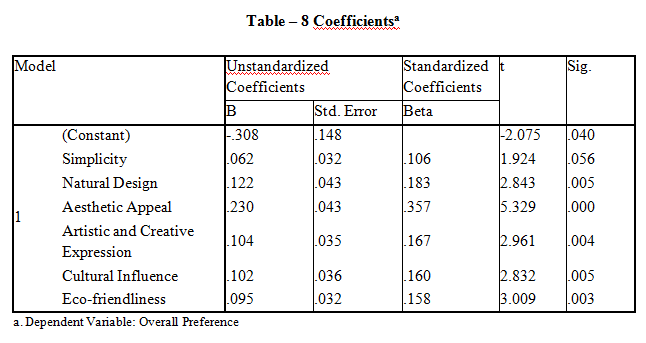|
Debasis Pani Research Scholar P.G. Department of Business Administration Berhampur University Email: debasispani@hotmail.com Contact No.- 9437271590/9338585700 |
Dr. Sunil Kumar Pradhan Lecturer P.G. Department of Business Administration Berhampur University Email: sunilsunita123@gmail.com Contact No.- 9437962191 |
India has the largest concentration of tribal population in the world and their lifestyle is very close to the nature. Likewise in Odisha, especially KBK (Undivided Koraput, Bolangir and Kalahandi) district has got unique identity for its tribal population and lifestyle. They are very sensitive to their typical culture and less prone to change. But the tribal of these areas posses specialized skills in the form of handicraft, which pass from one generation to another and is a source of their livelihood. Handicrafts are mostly defined as "Items made by hand, often with the use of simple tools, and are generally artistic and/or traditional in nature. They are also objects of utility and objects of decoration.” Moreover through these handicrafts, the tribal artesian can empower themselves because these products get huge response from the urban consumers, hence it becomes a source for their income earning.
This paper aims to study, how the demographic attributes like age and gender influences consumer preference towards tribal handicraft products and to know various attributes, which have a larger impact on purchase of tribal handicraft product. Though the study was undertaken in Rayagada district (undivided district of Koraput) during Chaiti festival, its scope is limited to the same district. The nature of this research is a descriptive research. A structured questionnaire was used to collect data. The survey instrument was subjected to overall reliability. The data was gathered through a five point Likert scale questionnaire from 150 respondents. Mean, Standard deviation, one way ANOVA and Regression analysis were carried out to serve the purpose of study.
Key words: Tribal Handicraft, Consumer Preference.
Handicrafts are unique expressions of a particular culture or community through local craftsmanship and materials. The tribal are good craftsmen and are adept in making handicrafts using the locally available resources. The tribal handicrafts are specialized skills which are passed on from one generation to another and these handicrafts are means of livelihood of the artisans. These localized handicraft sector can be transformed into livelihood opportunities and the products can be commercially marketed. The development of tribal handicraft sector would have been an initiative for holistic sustainable business model, which not only ensures fair and equitable remuneration to the artisans for their products but also propagate their cultural knowledge and traditional skills in the contemporary milieu.
The response of consumers to handicrafts is unpredictable and lends itself less to research and generalization than does the response to other products. However in the present days the tribal handicraft lovers are increasing enormously. (Dash, 2011), “Consumers buy handicrafts because they like to feel connected with indigenous traditions and cultures in a global and increasingly commoditized world.”1
The district Rayagada was carved out of the erstwhile Koraput district, as part of the extension plan of districts in the state. The district has a population of 832019, out of which 473379 are tribals. In other words, the district is predominantly a tribal populated district with 57.52 % of tribal population. The physiography of Rayagada gives a prefect platform for the tribal’s ethno-cultural identity in the district. The district has been the homeland of various tribal communities with their sub-tribes, who are found in different levels of development depending upon their assimilation with the so-called mainstream or modern communities. The kondhas and its subsection constitute the major percentage of tribal population in the district and the Souras stand second. There are also many other tribal communities who are, however, negligible in number but definitely contribute to the exotic intermingling culture of the district.
"Chaiti Festival" or "Rayagada Mahotsav" is the official annual mass cultural festival of Rayagada district. It is one of the major tourist attractions in the district. The festival started in 2005 in this district to give a boost to tribal culture. The festival is observed during the last three days of the year at the GCD High School ground by the District Council of Culture (DCC), Rayagada. The extravaganza shows the best of tribal art & culture of the district, with more than 500 artists across the country, is the main attraction in the festival. Very often the festival is followed by the Pallishree Mela of Orissa Rural Development & Marketing Society (ORMAS)
The Chaiti Festival is the perfect platform of promoting the handicraft of Rayagada. This event not only revealing the hidden talents of the tribal artisans of Rayagada to the world but also strengthening the Indian culture by escalating it in the global scenario.
Handicrafts are mostly defined as "Items made by hand, often with the use of simple tools, and are generally artistic and/or traditional in nature. They are also objects of utility and objects of decoration.” Handicrafts are the indigenous creation of ordinary people of villages.
The predominated ‘Kondhas’ and ‘Souras’ tribal community in the district of Rayagada have a tradition which remains unchanged or unaffected over generation, which is reflected in their handicraft. Earlier they were made with utilitarian motive but slowly the demand has increased and has transformed into an ample business opportunity. The various handicraft products made by the tribal of Rayagada district are shown to the public in the stall during chaiti festival are classified into Cane & Bamboo works, Clay modelling, Costume Jewelry, Cotton & Jute carpet, Dhokra casting, Golden grass, Horn works, Palm leaf scratching, Patta Chitra, Sabai grass, Stone carving, Tailoring & Embroidery, Wood carving.
The modern man lives in a mechanized society. He is tired of this complex and busy world. He finds freshness and simplicity in these productions of rural art. These handicrafts give him abundantly refreshment and artistic recreation. Undoubtedly, it is due to the change in positive attitude of modern consumer; the tribal handicrafts have begun to enjoy popularity throughout the world.
However a study on the buyer behaviour towards tribal handicraft is highly solicited which not only help us to understand the complex buying behaviour but also helps to understand the various attributes, which holds in forming positive consumer preference towards tribal handicraft. The field of buyer behavior studies how individuals, groups and organization select, buy, use and dispose the goods, service, ideas, or experience to satisfy their needs and desires. Understanding buyer behavior and knowing customer is never simple. An understanding of the consumer behaviour of various market segments help sellers to select the most effective product design, price, advertising appeals, channels of distribution.
However, studies in different aspects of consumer preference towards tribal handicraft product in the undivided KBK district or district of Rayagada are limited. Hence studying buyer behaviour about tribal handicraft product in a rapidly marketing environment needs a fresh outlook. The present study is a humble attempt to do this. Before it is done, a review of existing literature is presented below.
The aesthetic and cultural importance of handicrafts is highlighted in ‘handicrafts of India” by Abraham (1964). “Man’s association with art and craft dates back to the period when human civilization first started. He created stone weapons for safeguarding himself against furious animals in forests.” Analysing the literature we can make a note that Man is very close to nature from the development of civilisation, so nature has played an indispensable part in the development of the art and culture. The art of pottery, the cotton woven fabrics, stonework, basket weaving etc are the main art forms of ancient India.
The famous book of Kamaladevi Chattopadhyaya (1996) “Indian handicrafts” is a famous landmark in the Indian cultural field. She says that Indian handicrafts thrived through ages stimulated by a vigorous folk tradition, a benign culture, and in an age when individualism was cherished and precision valued.
(Tiwari, 2015) his research stated, “Handicrafts are the visible symbol of cultural behaviour.” He further has given a different perspective of craftsman to him. “Any articulated product in the sphere of creativity could be termed as an artistic handicraft. The person who imagines and creates these hand made goods of different origins forms is called as craftsman. Silpi, Kalakar, Ghadwa, Karigar etc. The craft culture of India shows the firm base in the country's age old artistic traditions.” The research laid by Tiwari indicates that handicraft products reflect the culture of the society and creativity of artisans.
(Mohapatra, 1987) in his book has given a clear picture about Orissa and focuses on the Orissa handicrafts elaborately. Kannungo, (1964) in “Utkalana Chitrakara” ( the art and craft of Orissa) has briefly describes the patta painting as one of the old paintings is typical in its style where the theme basically depicts the religious tradition of India. It is closely associated with the culture of Jagannath. Samal,(1994) has done her research work in “Applique craft tradition of Orissa and change”. She has describes about position of appliqué in Orissa and its development according to time.
(Dash, 2011) in her research paper, highlighted the importance of handicraft which describes, “India which consist of a variety of ethnic traditions and culture, is also a treasure house of handicrafts. Exquisite handicrafts using diverse raw materials are produced in different parts of the country. This include art metal ware, wood ware, hand printed textiles and scarves, applique, leather crafts, pattachitra, hand knotted and embroidered goods, shawls as art ware, stone carvings, zari and zari goods, imitation jewellery, filigree and miscellaneous other handicrafts. One of the unique feature of the handicrafts is that more often the same item of the handicraft, produced in different regions, are different from each other in terms of the craftsmanship, style, colour combination and finish.” The above study gives us an idea about the aesthetic appeal and uniqueness of tribal handicraft as it is bestowed by their respective culture. Moreover the raw material used, processing of it and the final product is very much ecofriendly, which entices more towards today’s environment sensitive consumers.
The aesthetic appeal of tribal handicraft is centred on its unique design which is very much described in the study of (Planning commission report, 2006), “Designing is a very vast subject and has different meanings for item to item, source to source and product for academic and practical purpose separately. The designing can be categorized in five types viz.: Natural design, Decorative & Stylish Design, Structural Design, Geometrical Design, Abstract Design.”
Arindam (2010) has expressed though Tunisia online news about the importance of handicraft sector in the economic development as well as its role in strengthening the cultural identity, heritage preservation which contributes to the overall development , creating job, opportunities ,demand creation for the artisans and promoting
exports. (Rao,1978) in his book “ Marketing of Handicrafts” observed that “Handicrafts offer solution to India, which is characterized by unemployment and foreign exchange crunch”. By analysing the literature we are sure that handicraft is not only an artistic recreation but also a solution to many economic problems because this sector has high employment potential, low per capita investment and high value addition, involvement of women and weaker section. Moreover this sector is the largest employer, next only to agriculture in the rural India.
Reviewing from the available literature, it can be noticed that various attributes of tribal handicraft like Simplicity, Natural design, Aesthetic appeal, Artistic and Creative Expression, Cultural Influence and Eco-friendliness are the major attributes which forms overall preference of consumer. This forms the context for study for the present research.

Objectives of the Study
1. To study relationship between all the variables that we have undertaken with overall preference.
2. To study the relationship between overall preference with demographics factors (age, gender).
Population and Sample Size – Whole population of Rayagada District who visited various stalls showing tribal handicraft during Chaiti festival. Sample size of 150 Customers (Including 80 male and 70 female Customer were surveyed.)
Data Collection - The current study understands the impact of demographic variables towards on consumer preference towards tribal handicraft. Primary data was collected with a self administered questionnaire. Convenience sampling approach was adopted in order to collect the primary data.
Survey Instrument - A structured questionnaire was developed with five point
Likert scale, with 1 the strongly disagree and 5 the strongly agree for various variables such as Simplicity, Natural Design, Aesthetic Appeal, Artistic and Creative Expression, Cultural Influence and Eco-friendliness. A three point Likert scale developed to measure the Overall Preference variable, with 1for Unfavourable, 2 for Neutral and 3 for Favourable. It was developed with discussion of experts and review of literature.
Statistical Tools - Data analysis was done using statistical package for social science
(SPSS) version 20.0 for the data gathered through structured questionnaire. Mean, Standard Deviation, Regression Analysis and one way ANOVA were used as statistical tools.
Scope of the Study - Though the study was undertaken in Rayagada district (undivided district of Koraput) during Chaiti festival, its scope is limited to the same district.
Sample Profile - Demographic features of all the customers who have visited the various stalls showing tribal handicraft products during Chaiti festival in the district of Rayagada, are exhibited with the help of table 1 below:

Reliability Statistics:- The reliability of scale indicates that the study is free from random error. Internal consistency is measured in this research using Cronbach’s coefficient alpha, (a). The statistic provides an indication of the average correlation among all of the items that make up the scale. Values range from 0 to 1 with higher values indication greater reliability.

Table above indicates the result of analysis of the Cronbach’s alpha scale is 0.855, where its value is more than 0.8, which shows a greater reliability in any kind of social research. This indicates that the survey instrument (questionnaire) can be liable tool to measure the construct consistently.
Descriptive Statistics:- the level of overall positive preference perceived by the customers in relation to identified attributes of tribal handicraft are shown in table 3, which shows the mean values, standard deviation and variance for the variables.

The mean score on overall positive preference was found to be 2.44 on a three point Likert scale. This is above the neutral score of 1.5, which implies that respondents’ overall preference is favorable/positive. Based on a five point Likert type scale ranging from strongly disagree (1) to strongly agree (5), the survey conducted for knowing the response of faculties on various attributes relating to overall preference towards tribal handicraft. The mean scores of all independent variables are above the neutral score 3, which implies for favourable or positive outcome. According to these results, Natural Design followed by Simplicity, Artistic and Creative Expression has impacted a lot in forming overall positive preference.
Relationship between Overall Preference of the customers with demographics factors (age, gender):
1st Hypothesis: Relationship between Overall Preference of customers with demographics factors (age).
H0: The Overall Preference does not vary in accordance with age
H1: The Overall Preference varies in accordance with age.

To analysis hypothesis that is there difference in Overall Preference according to age, we use One Way ANOVA. The results is F (3,146) = 0.760, p = 0.518, where p>0.05 so result is not significant at 5%. We have to accept the null hypothesis. That Overall Preference does not vary in accordance with age.
2nd Hypothesis: Relationship between overall QWL of faculty members with demographics factors (Gender).
H0: The Overall Preference does not vary in accordance with gender.
H1: The Overall Preference vary in accordance with gender.
To analyze that is there significant difference perceived by male and female customers in relation to Overall Preference, we use one way ANOVA.

To analysis hypothesis that is there difference in Overall Preference according to gender, we use One Way ANOVA. The results is F (1,148) = 0.002, p=0.963 where p>0.05 so result is not significant at 5%. We have to accept the null hypothesis. The Overall Preference does not vary in accordance with gender.
To test whether the identified factors are good predictor of Overall Preference.
To analysis the relationship between overall preference and the identified factors, we use linear regression model.

The table-6 is Model Summary. This table provides the R, R2, adjusted R2, and the standard error of the estimate, which can be used to determine how well a regression model fits the data.
Ø R represents multiple correlation coefficient, whose value is 0.854 which indicates a good level of prediction
Ø R2 represents coefficient of determination, whose value is 0.730, which means our independent variables explains 73.0% of the variability of our dependent variable.
Ø Adjusted R2 value is 0.719, which shows the model 71.9% accurately report our data.

3rd Hypothesis: Relationship between identified factors and overall preference
H0: There is no significant relationship between identified factors and overall preference.
H1: There is significant relationship between identified factors and overall preference.
The F-ratio in the ANOVA table shows that the identified factors (Independent Variables) statistically significantly predict the overall preference (Dependent Variable), F(6,143) = 64.422, p < 0.0005 so the result is significant. H0 is rejected. Hence the overall regression model is a good fit for the data. The table shows that the independent variables statistically significantly predict the dependent variable.

In the above coefficient table the unstandardized coefficients indicate how much the Overall Preference (dependent variable) varies with the identified factors (independent variable) when all other independent variables are held constant.
Ø All the identified factors affecting the overall preference have a positive relation with the overall preference.
Ø Aesthetic Appeal factor have highest impact on the overall preference as its Beta value is 0.230
Ø Simplicity factor have lowest impact on the overall preference as its Beta value is 0.062
Ø Except Simplicity factor all the identified independent factors affecting overall preference are not statistically significant.
This empirical study has revealed deep rooted insights of consumer’s preference in connection to tribal handicraft products. The present study was a sincere attempt to know the impact demographic variables on consumer preference towards tribal handicraft. The study reveals, demographic factors like age and gender do not have significant role in influencing the consumer preference and consumers are highly inclined towards the simplicity, natural design, aesthetic appeal, artistic and creative expression, cultural influences and eco-friendliness attributes in buying tribal handicrafts. Moreover these attributes not only entices but also plays the role of catalyst in forming positive preference of modern consumer.
The study is useful for the organizations, researchers and academicians, in studying buyer behaviour for tribal handicraft products. However emergence of digital platform and widespread of cosmopolitan culture is having a significant impact on forming positive preference on today’s value seeking consumers. So these forces influence the consumer preference towards this unique tribal handicraft sector which may be taken as scope for further research.
1. Dash. M(2011), “Marketing of Odisha Handicrafts: A study on Challenges & Opportunities.”, Excel International Journal of Multidisciplinary Management Studies, Vol.1, Issue 2, p-47
2. Abraham, T, “Hadicrafts of India” ,Graphics Columbia, New Delhi, 1964.
3. Chattapadhya, Kamaladevi, The glory of Indian Handicrafts, Indian Book Company, New Delhi.1996.
4. Tiwary.AK (2015), “Bastar Handicrafts: The Visible Cultural Symbol of Bastar Region of Chattisgarh.”,International Journal of Research in Humanities, Arts and lItreature, Vol.3, Issue2, feb2015,43-48.
5. Mohapatra, Jayanta, Orissa Lustre Press Pvt. Ltd, New Delhi.1987.
6. Samal,Banani, Appliqué Craft Tradition of Orissa and Change, Ph.D. Thesis of Department of Anthropology, Utkal University. 1994.
7. Planning commission report, Status study of tribal handicraft-an option for livelihood of tribal community in the states of arunachal pradesh rajasthan, uttaranchal and Chhattisgarh, May 2006.
8. Arindam Sinha,The Finanancial Express, 3, June, 2010.
9. Rao, R.V., Rural Industrialization in India (The Changing Profile): Concept Publishing Company, Delhi.1978.
11. www.wikipedia.org